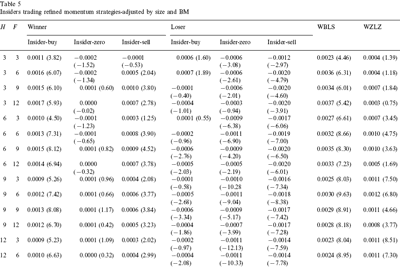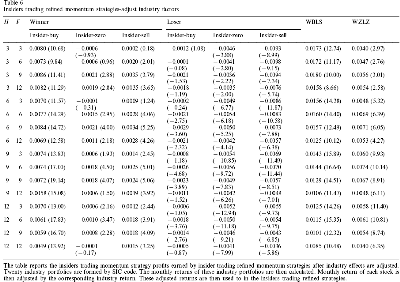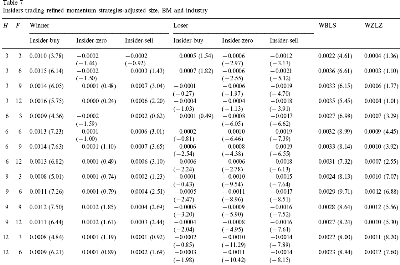To study the risk dispersion between the WB and LS, we first considered two widely accepted factors: size and BM (book equity/market equity ratio). We first rank all the New York Stock Exchange stocks in the Center for Research in Stock Prices (CRSP) database on size (share price multiply shares outstanding in June of each year t from 1985 to 1996). Five quintiles are then formed by the rank and determine four breakpoints. The stocks in the American Stock Exchange (AMEX) and NASDAQ are then allocated to the five groups based on the four breakpoints. All stocks are also broken into five BM groups based on the breakpoints determined by stocks in NYSE. We obtain the book value of each company from COMPUSTAT and match it with the stock market information such as price and shares outstanding from CRSP.
To guarantee the arrival of annual report, the year t’s BM breakpoints are determined by the BM ratio in December of year t−1. We rank all NYSE stocks into five quintiles on BM ratio and determine four BM breakpoints. All the stocks in NYSE, AMEX and NASDAQ are then allocated into five groups based on these four BM breakpoints. Twenty five equal-weighted size-BM portfolios are then formed as the intersection of these five size-sorted groups and five BM sorted groups. The monthly returns of these portfolios are calculated from July of year t to June of year t+1.
Each stock is then matched with its corresponding size-BM portfolios and its return is adjusted by the matched size-BM portfolio return. The refined momentum portfolios are formed following the same processes described in Section 3.3. At the beginning of each month t, six portfolios: WB, WZ, WS, LB, LZ, LS are formed based on past F month return performance and AITR dummies. These positions are held for H months from t+1 and the equal-weighted adjusted returns of these portfolios are calculated. Table 5 reports the adjusted returns of individual portfolios and refined momentum strategies.
Compare the size and BM adjusted profits with the unadjusted profits in Section 3.3, we can find that the WBLS can still earn significant profits, while the WZLZ can only earn a very low profit. The adjusted profit earned by WBLS is 0.32% per month now. The 6/6 WZLZ can earn 0.1% per month. If we consider the transaction cost, the WZLZ cannot earn profit any more. The findings show that the profits earned by our refined strategies cannot be explained by risk factors. However, momentum effects disappeared among those stocks without clear insider trading information. After controlling the insiders trading information and the risk factors, the momentum effects disappeared. We argue that the naı¨ve momentum effects may come from two sources: the risk dispersion effects and the effects caused by irrational reaction of investors.
Adjust the industry factor
Grinblatt and Moskowitz (1999) state that the industry component of stock returns accounts for much of the individual stock momentum anomaly. In this section, we study influence of industry factor in our refined strategies. In each month, the stocks in NYSE, AMEX and NASDAQ in CRSP database are sorted into 20 industry groups based on Standard Industry Code (SIC). The equalweighted monthly returns of the 20 groups are then calculated. Each stock is then matched with its corresponding industry groups and the returns are deducted by the returns of industry portfolios. We then form portfolios following the processes described in Section 3.3. Table 6 reports the profits earned by refined momentum strategies after adjust industry factors.
The results show that the momentum effects are not removed after the industry factor is adjusted. The 6/6 refined momentum strategy as an example, the strategy can earn 1.66% per month before we adjust the industry factors, while it still can earn 1.60% per month after adjusting the industry factor. This should support our belief that the industry factor cannot capture the momentum effects of our refined strategy. We further studied the influence of industry factor by combining it with the size and BM factors together.
To do so, we first set up the equal-weighted Size-BM portfolios using the method described in Section 3.4. Each stock is then matched with its corresponding Size-BM portfolios. All stocks in NYSE, AMEX and NASDAQ are then sorted into 20 industry groups on SIC code and the equal-weighted monthly return of these industry portfolios are then matched with each stock. The monthly return of each stock is then adjusted by the return of its corresponding of Size-BM and industry portfolios. Table 7 reports the size, BM and industry adjusted returns of the individual portfolios, and refined momentum strategies.
Not surprising, the results reported in Table 7 are similar with the results in Table 5. As before, we use the 6/6 strategies as an example, the size, BM and industry earned by WBLS, WBLB, WBWS, WSLS, LBLS and WZLZ are 0.32, 0.15, 0.07, 0.25, 0.17, and 0.09% per month respectively, while size and adjusted profits earned by the same strategies are 0.32, 0.15, 0.06, 0.27, 0.17 and 0.1% per month, the momentum effects still exist. The findings again reject the assumption that the risk factors or industry factor can explain the momentum effects. Our interpretation is an improvement of the irrational models in previous literatures and based on the experimental psychology findings. There are at least two widely accepted psychology findings: First, people are slow to renew their beliefs when they get the new information. Second, self-attribution bias, people do not judge outcomes on an absolute scale, but compare outcomes with an initial reference point.
When the coming signal is consistent with their initial observations, they will overreact, but when the coming signal is not consistent with their initial observation, they will be slow to change their initial beliefs and only react modestly. The self-attribution bias may provide us the possibility of the continuous overreaction. When the coming signals are consistent with initial observations, investor will overreact continuously. This is consistent with the argument of Daniel et al. (1998). The continuous overreaction is the source of mediate term momentum effects. In long run, the overly price will be corrected and induce long-term reversals.
The story has the following implications: First, investors overreact on WB and LS continuously. Second, they only react modestly on WS, LB, WZ and LZ. These implications will predict that the WBLS will capture the widest spread and WSLB has the narrowest spread. The spreads of WSLS, WZLZ, WBLB, LBLS and WBWS should be narrower than WBLS and wider than WSLB. It may also predict these spread may be reversed in long run. Our findings show that WBLS does have a wider spread than any other zero-positions, while WSLB has the narrowest spread. 6/6 strategies as an example, the size, BM and industry adjusted return earned by WBLS, WBLB, WBWS, WSLS, LBLS and WZLZ are 0.32, 0.15, 0.07, 0.25, 0.17, and 0.09% per month respectively. In the following sections, we will study the long-term performance to test the long run prediction made by our explanations.
Jihong Xiang, Jia He , Min Cao
Next: Long-term reversal
Summary: Index



